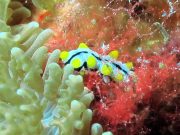Tauchen mit Holothuriidae Seegurken
Meeresleben von Lanta | Holothuriidae
Die Familie der Holothuriidae umfasst etwa 185 Seegurken, von denen wir einige in großer Zahl beim Tauchen von Koh Lanta finden können.
Die Seegurken der Holothuriidae haben dicke, fleischige Körper, die von klein bis sehr groß reichen und oft mit kleinen, abgerundeten Fortsätzen, den so genannten Papillen, bedeckt sind. Alle Arten haben viele röhrenförmige Füße am Unterkörper und mehrere Arten haben 15 bis 30 Mundtentakel.
Wenn sie gestresst oder angegriffen werden, können viele Mitglieder dieser Familie viele feine, klebrige, weiße Fäden aus ihrem Anus ausstoßen, die so genannten Cuvierian Tubuli. Diese Röhren können ein Raubtier fesseln und außer Gefecht setzen. Die Röhren können innerlich abgetrennt werden und wachsen dann innerhalb von 2 bis 4 Wochen wieder nach.
Je nach Art können sich Seegurken unter Felsen und Geröll verstecken, im Sand eingegraben sein, freiliegend gefunden werden oder sich in einigen Fällen aktiv mit ihren Reihen klebriger Röhrenfüße im Korallenriff bewegen. Einige wenige Arten sind tagsüber aktiv, die meisten sind jedoch nachts aktiv.
4 Arten auf dieser Seite gefunden:
Elephant trunkfish
(Holothuria fuscopunctata)
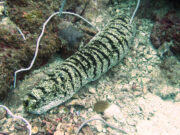
Holothuria fuscopunctata @ Koh Haa
The Elephant trunkfish is a large sea cucumber with a thick body wall, generally golden-brown with dark spots and dark brown wrinkles along its entire body length.
The underside is whitish, the mouth being surrounded by twenty thick brown tentacles and the anus surrounded by a black band.
This sea cucumber can reach up to 70 cm and can weigh up to 4.5kg, though it’s spotted around Lanta more commonly in the 30 - 50 cm range.
This species is normally found down to 30 m, is slow to mature and has a low fertility rate.
Graeffe's Sea Cucumber
(Pearsonothuria graeffei)
The Graeffe's Sea Cucumber is one of the most common sea cucumbers encountered at the dive sites around Koh Lanta. This species of sea cucumber has a white body, with many light, thorny projections surrounded by pale brown blotches. There are many small dark spots all over the body and hundreds of small tube feet on the lower body.
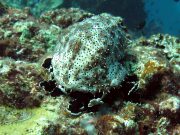
Adult Pearsonothuria graeffei @ Koh Haa
Around the mouth are around 20 - 24 tentacles comprising black stalks with leaf-like ends. The leaves are black on the top and white on the bottom and help to ‘feel’ the way around the coral reef.
This species grows up to 30 cm, are very light-weight and are very thin-walled and ‘floppy’ if picked up (we have rescued some from a fishing trap, but do not recommend touching any marine life in the course of a normal dive).
Small juvenile Graeffe's Sea Cucumbers mimic the phyllidiid sea slug Phyllidia varicosa for protection (many nudibranchs are poisonous and distasteful to predators), and as they grow larger than the nudibranch they are impersonating, they start to take on the adult sea cucumber colouration and form. (see photos)
Pinkfish Sea Cucumber
(Holothuria edulis)
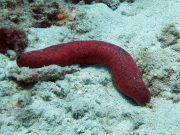
Holothuria edulis @ Koh Rok
The Pinkfish Sea Cucumber has a reddish-pink cylindrical body with rounded ends. There is sometimes a black area on the back/upper body, however this species can also be other colours, such as grey or dark brown.
The lower body has rows of small tube feet which help with movement, and which can be retracted into the body if necessary.
There are around 20 oral tentacles which can help with feeding, movement and also righting itself if it is overturned.
The Pinkfish Sea Cucumber grows to 35 cm and is found over sand and rubble is shallow areas of coral reefs.
Blue Sea Cucumber
(Actinopyga caerulea)
The Blue Sea Cucumber has a loaf-shaped body with some tapering toward each end. The body colour is mostly bluish, with white patches. The bluish areas are covered with small conical 'papillae', which are absent in the white areas.
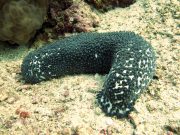
Actinopyga caerulea @ Koh Haa
The mouth of a Blue Sea Cucumber is on the bottom, surrounded by 15 to 18 large bluish-grey tentacles, which in turn are surrounded by a collar of bluish papillae.
The anus of the Blue Sea Cucumber is at the rear end, surrounded by 5 white anal teeth.
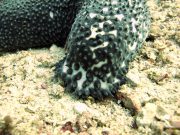
Actinopyga caerulea @ Koh Haa
Unlike many other members of the family Holothuriidae, the Cuvierian organ is absent in Blue Sea Cucumbers and this species is unable to eject Cuvieran tubules if stressed.
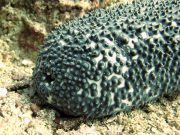
Actinopyga caerulea @ Koh Haa
Tauchen mit Holothuriidae Seegurken rund um Koh Lanta
Tauch- und Schnorchelausflüge
Wenn Sie gerne die Gelegenheit hätten, Holothuriidae Seegurken auf einem unserer täglichen Tauchausflüge während der Hochsaison von Koh Lanta aus zu sehen, dann senden Sie uns eine E-Mail an info@diveandrelax.com.
Nehmen Sie an unseren Speedboot-Tauchausflügen in der Hochsaison zu einigen der besten Tauchplätze Thailands teil und genießen Sie kleine Gruppen, kurze Fahrzeiten und einen Fokus auf hervorragenden persönlichen Service, Sicherheit und Spaß.
Noch kein zertifizierter Taucher? Lernen Sie auf Koh Lanta das Tauchen mit dem 3-tägigen SSI Open Water Diver Kurs.
Buchen Sie online und sparen Sie 10% auf Tauchausflüge und Tauchkurse auf Koh Lanta.
Weitere Informationen
Indo-Pazifische Meereslebewesen-Führer
- Allen, G., Steene, R., Humann, P., DeLoach, N. (2003) Reef Fish Identification, Tropical Pacific. Jacksonville, FL., USA: New World Publications, Inc., ISBN 1-878348-36-1.
- Humann, P., DeLoach, N., (2010) Reef Creature Identification, Tropical Pacific. Jacksonville, FL., USA: New World Publications Inc., ISBN 978-1-878348-44-9
- Debelius, H. (2013) Indian Ocean Reef Guide. Frankfurt, Germany: IKAN - Unterwasserarchiv, ISBN 978-3-939767-52-7.
- Debelius, H. (2004) Nudibranchs and Sea Snails, Indo-Pacific Field Guide. Frankfurt, Germany: IKAN - Unterwasserarchiv, ISBN 3-925919-51-1
- Erhardt, H., Knop, D. (2015) Corals Indo-Pacific Field Guide. Frankfurt, Germany: IKAN - Unterwasserarchiv, ISBN 3-925919-69-4.
- Veron J.E.N., Stafford-Smith M.G., Turak E. and DeVantier L.M. (2016). Corals of the World
Weitere Referenzen zu Meereslebewesen und weitere Informationen


